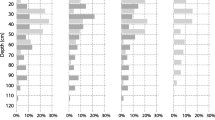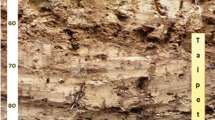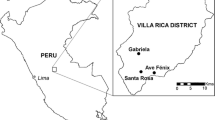Abstract
The agroforestry systems are a potential pathway to improve soil quality and protect against extreme temperatures that negatively impact coffee growth. However, more studies about the effects of inclusion of tree elements in coffee systems soil and water loss dynamics are needed. This study aimed to understand how the inclusion of trees influences the microclimate and soil and water loss in shaded compared with unshaded coffee systems. Two pluviometers, one in shaded and the other in unshaded area, were installed to record hourly data from August 2009 to June 2010. Soil temperature and moisture were monitored by a system of sensors: air temperature, soil temperature at 10 cm depth, and soil moisture at 10, 30 and 100 cm depths, recording data at hourly intervals from August 2009 to June 2010. The surface water runoff and soil mass lost by laminar erosion were measured using collectors. Air temperature under shaded conditions had less variation than under unshaded conditions and lower maximum temperatures. Soil and water loss of both systems were small due to the high soil cover. Our results indicate that the water loss was higher in the unshaded area (338 L ha−1) during the study period compared with the shaded system (150 L ha−1). Soil temperature was lower under shaded conditions and there was water absorption complementarity between coffee and trees in shaded area. Soil moisture of shaded area was lower than unshaded area for all depths in all monitored period. Therefore, the shaded agroforestry coffee systems improve microclimate conditions and deep water drainage compared with unshaded coffee systems.







Similar content being viewed by others
References
Aguiar MI de (2008) Qualidade Física dos Solos em Sistemas Agroflorestais. Universidade Federal de Viçosa.
Arcova FCS, de Cicco V, Rocha PAB (2003) Precipitação efetiva e interceptação das chuvas por floresta de Mata Atlântica em uma microbacia experimental em Cunha - São Paulo. Rev Árvore 27:257–262. https://doi.org/10.1590/S0100-67622003000200014
Barreto CVG, Sakai E, Arruda FB et al (2006) Distribuição espacial do sistema radicular do cafeeiro fertirrigado por gotejamento em Campinas. Bragantia 65:641–647. https://doi.org/10.1590/S0006-87052006000400015
Bertolani FC, Vieira SR (2001) Variabilidade espacial da taxa de infiltração de água e da espessura do horizonte A, em um argissolo vermelho-amarelo, sob diferentes usos. Rev Bras Ciência do Solo 25:987–995. https://doi.org/10.1590/S0100-06832001000400021
Camargo AP (1985) O clima e a cafeicultura no Brasil. Inf Agropecuário 11:13–26
Cannell MGR, Van Noordwijk M, Ong CK (1996) The central agroforestry hypothesis: the trees must acquire resources that the crop would not otherwise acquire. Agrofor Syst 34:27–31. https://doi.org/10.1007/BF00129630
Caramori PH, Kathounian CA, Morais H, et al (2004) Arborização de cafezais e aspectos climatológicos. In: Matsumoto SN (ed) Arborização de Cafezais no Brasil. pp 19–42
Cardoso I, Guijt I, Franco F et al (2001) Continual learning for agroforestry system design: university, NGO and farmer partnership in Minas Gerais, Brazil. Agric Syst 69:235–257. https://doi.org/10.1016/S0308-521X(01)00028-2
da Silva CG, Alves Sobrinho T, Vitorino ACT, de Carvalho DF (2005) Atributos físicos, químicos e erosão entressulcos sob chuva simulada, em sistemas de plantio direto e convencional. Eng Agrícola 25:144–153. https://doi.org/10.1590/S0100-69162005000100016
de Camargo ÂP, de Camargo MBP (2001) Definição e esquematização das fases fenológicas do cafeeiro arábica nas condições tropicais do Brasil. Bragantia 60:65–68. https://doi.org/10.1590/S0006-87052001000100008
de Carvalho DF, Montebeller CA, da Cruz ES et al (2002) Perdas de solo e água em um Argissolo Vermelho Amarelo, submetido a diferentes intensidades de chuva simulada. Rev Bras Eng Agrícola e Ambient 6:385–389. https://doi.org/10.1590/S1415-43662002000300001
de Gomes L, C Cardoso IM, Mendonça E de S et al (2016) Trees modify the dynamics of soil CO 2 efflux in coffee agroforestry systems. Agric For Meteorol 224:30–39. https://doi.org/10.1016/j.agrformet.2016.05.001
de Souza HN, Cardoso IM, de Sá ME et al (2012) Learning by doing: a participatory methodology for systematization of experiments with agroforestry systems, with an example of its application. Agrofor Syst 85:247–262. https://doi.org/10.1007/s10457-012-9498-4
DaMatta FM (2004) Ecophysiological constraints on the production of shaded and unshaded coffee: a review. F Crop Res 86:99–114. https://doi.org/10.1016/j.fcr.2003.09.001
Diniz AR, Pereira MG, de Balieiro F et al (2013) Precipitação e aporte de nutrientes em diferentes estádios sucessionais de Floresta Atlântica, Pinheiral - RJ. Ciência Florest 23:389–399. https://doi.org/10.5902/1980509810550
Donatti CI, Harvey CA, Martinez-Rodriguez MR et al (2019) Vulnerability of smallholder farmers to climate change in Central America and Mexico: current knowledge and research gaps. Clim Dev 11:264–286. https://doi.org/10.1080/17565529.2018.1442796
Drewnik M (2006) The effect of environmental conditions on the decomposition rate of cellulose in mountain soils. Geoderma 132:116–130. https://doi.org/10.1016/j.geoderma.2005.04.023
Drinnan JE, Menzel CM (1994) Synchronization of anthesis and enhancement of vegetative growth in coffee ( Coffea arabica L.) following water stress during floral initiation. J Hortic Sci 69:841–849. https://doi.org/10.1080/14620316.1994.11516520
Duarte EMG, Cardoso IM, Stijnen T et al (2013) Decomposition and nutrient release in leaves of Atlantic Rainforest tree species used in agroforestry systems. Agrofor Syst 87:835–847. https://doi.org/10.1007/s10457-013-9600-6
EMPRAPA 2017 Manual de métodos de análises de solos 3 Brasília DF
Franco FS, Couto L, de Carvalho AF et al (2002) Quantificação de erosão em sistemas agroflorais e convencionais na Zona da Mata de Minas Gerais. Rev Árvore 26:751–760. https://doi.org/10.1590/S0100-67622002000600011
Gomes LC, Bianchi FJJA, Cardoso IM et al (2020a) Land use and land cover scenarios: an interdisciplinary approach integrating local conditions and the global shared socioeconomic pathways. Land Use Policy 97:104723. https://doi.org/10.1016/j.landusepol.2020.104723
Gomes LC, Bianchi FJJA, Cardoso IM et al (2020b) Agroforestry systems can mitigate the impacts of climate change on coffee production: a spatially explicit assessment in Brazil. Arg Ecosyst Environ 294:106858. https://doi.org/10.1016/j.agee.2020.106858
Graeub BE, Chappell MJ, Wittman H et al (2016) The state of family farms in the world. World Dev 87:1–15. https://doi.org/10.1016/j.worlddev.2015.05.012
Gómez-Delgado F, Roupsard O, le Maire G et al (2011) Modelling the hydrological behaviour of a coffee agroforestry basin in Costa Rica. Hydrol Earth Syst Sci. https://doi.org/10.5194/hess-15-369-2011
Hurni H, Giger M, Liniger H et al (2015) Soils, agriculture and food security: the interplay between ecosystem functioning and human well-being. Curr Opin Environ Sustain 15:25–34. https://doi.org/10.1016/j.cosust.2015.07.009
Jackson N, Wallace J, Ong C (2000) Tree pruning as a means of controlling water use in an agroforestry system in Kenya. For Ecol Manage 126:133–148. https://doi.org/10.1016/S0378-1127(99)00096-1
Jaramillo J, Chabi-Olaye A, Kamonjo C et al (2009) Thermal tolerance of the coffee berry borer hypothenemus hampei: predictions of climate change impact on a tropical insect pest. PLoS ONE 4:e6487. https://doi.org/10.1371/journal.pone.0006487
Lamberto G (1975) Zoneamento Ecológico do Estado de Minas Gerais para reflorestamento. Belo Horizonte, MG
Lehmann J, Peter I, Steglich C et al (1998) Below-ground interactions in dryland agroforestry. For Ecol Manage 111:157–169. https://doi.org/10.1016/S0378-1127(98)00322-3
Lin BB (2010) The role of agroforestry in reducing water loss through soil evaporation and crop transpiration in coffee agroecosystems. Agric For Meteorol 150:510–518. https://doi.org/10.1016/j.agrformet.2009.11.010
Lott JE, Khan AAH, Black CR, Ong CK (2003) Water use in a Grevillea robusta–maize overstorey agroforestry system in semi-arid Kenya. For Ecol Manage 180:45–59. https://doi.org/10.1016/S0378-1127(02)00603-5
Motta ACV, Nick JA, Yorinori GT, Serrat BM (2006) Distribuição horizontal e vertical da fertilidade do solo e das raízes de cafeeiro (Coffea arabica L.) cultivar Catuaí. Acta Sci Agron 28:455–463. https://doi.org/10.4025/actasciagron.v28i4.758
Oliveira Júnior JC, de, Dias HCT, (2005) Precipitação efetiva em fragmento secundário da Mata Atlântica. Rev Árvore 29:9–15. https://doi.org/10.1590/S0100-67622005000100002
Pereira HC (1957) Field measurements of water use for irrigation control in Kenya coffee. J Agric Sci 49:459–466. https://doi.org/10.1017/S0021859600038466
Pinto HS, Zullo Junior J, Assad ED et al (2001) Zoneamento de riscos climáticos para a cafeicultura do estado de São Paulo. Rev Bras Agrometeorol 9:495–500
Rena AB, Guimarães PTG (2000) Sistema radicular do cafeeiro: estrutura, distribuição, atividade e fatores que o influenciam. Belo Horizonte, MG
Resende M, Curi N, de Rezende SB et al (2014) Pedologia: base para distinção de Ambientes, 6th edn. Neput, Viçosa, MG
Richards LA (1954) Diagnosis and Improvement of Saline and Alkali Soils. AIBS Bull 4:14–14. https://doi.org/10.1093/aibsbulletin/4.3.14-a
Ritchie JT (1998) Soil water balance and plant water stress. In: Tsuji GY, Hoogenboom G, Thornton PK (eds) Understanding Options for Agricultural Production. Springer, Newyork
Rosenzweig C, Strzepek KM, Major DC et al (2004) Water resources for agriculture in a changing climate: international case studies. Glob Environ Chang 14:345–360. https://doi.org/10.1016/j.gloenvcha.2004.09.003
Ruiz HA (2005) Incremento da exatidão da análise granulométrica do solo por meio da coleta da suspensão (Silte + Argila). Rev Bras Ciência do Solo 29:297–300. https://doi.org/10.1590/S0100-06832005000200015
Santos IR, Fávaro DIT, Schaefer CEGR, Silva-Filho EV (2007) Sediment geochemistry in coastal maritime Antarctica (Admiralty Bay, King George Island): Evidence from rare earths and other elements. Mar Chem 107:464–474. https://doi.org/10.1016/j.marchem.2007.09.006
Scheer MB (2009) Fluxo de nutriente pela precipitação pluviométrica em dois trechos de floresta ombrófila densa em Guaraqueçaba, Paraná. Floresta 39:117–130. https://doi.org/10.5380/rf.v39i1.13732
Sediyama GC (2001) Zoneamento agroclimático do cafeeiro (Coffea arabica L.) para o estado de Minas Gerais. Rev Bras Agrometeorol 9:501–509
Silva EA, DaMatta FM, Ducatti C et al (2004) Seasonal changes in vegetative growth and photosynthesis of Arabica coffee trees. F Crop Res 89:349–357. https://doi.org/10.1016/j.fcr.2004.02.010
Soares AR, Mantovani EC, Soares AA et al (2007) Produção e distribuição de raízes em cafeeiros irrigados por gotejamento. Eng na Agric 15:130–140
Souza HN, Cardoso IM, Fernandes JM et al (2010) Selection of native trees for intercropping with coffee in the Atlantic Rainforest biome. Agrofor Syst 80:1–16. https://doi.org/10.1007/s10457-010-9340-9
Tscharntke T, Clough Y, Bhagwat SA et al (2011) Multifunctional shade-tree management in tropical agroforestry landscapes - a review. J Appl Ecol 48:619–629. https://doi.org/10.1111/j.1365-2664.2010.01939.x
USDA (2017) Soil survey manual. USDA Handb, Government Printing Office, Washington, D.C.
van Kanten R, Schroth G, Beer J, Jiménez F (2005) Fine-root dynamics of coffee in association with two shade trees in Costa Rica. Agrofor Syst 63:247–261. https://doi.org/10.1007/s10457-005-4163-9
Yeomans JC, Bremner JM (1988) A rapid and precise method for routine determination of organic carbon in soil. Commun Soil Sci Plant Anal 19:1467–1476. https://doi.org/10.1080/00103628809368027
Acknowledgement
We thank the farmers for providing access to their farms for the study and the knowledge shared and to Dr. Ecila Mercês de Albuquerque Villani for the review carried out. This study was partly financed by the Coordenação de Aperfeiçoamento de Pessoal de Nível Superior (CAPES)—Brasil—Finance Code 001 and Brazilian National Research and Technology Council (CNPq).
Author information
Authors and Affiliations
Corresponding author
Additional information
Publisher's Note
Springer Nature remains neutral with regard to jurisdictional claims in published maps and institutional affiliations.
Rights and permissions
About this article
Cite this article
de Carvalho, A.F., Fernandes-Filho, E.I., Daher, M. et al. Microclimate and soil and water loss in shaded and unshaded agroforestry coffee systems. Agroforest Syst 95, 119–134 (2021). https://doi.org/10.1007/s10457-020-00567-6
Received:
Accepted:
Published:
Issue Date:
DOI: https://doi.org/10.1007/s10457-020-00567-6




